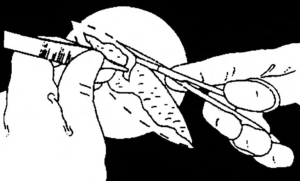(1) Debridement of adherent foreign material. Follow this procedure.
(a) Irrigate the wound. Carefully explore the wound for any foreign material.
NOTE: Foreign material serves as a source of infection and may “tattoo” the skin if the material is near the skin surface.
(b) Remove the foreign material. The simplest method is to abrade the soiled region repeated with a 4 x 4 inch piece of gauze moistened with saline. An alternate method is to excise the soiled tissue using forceps and an iris scissors or scalpel.
Watch a Video: Wound Debridement
(2) Trimming the wound edge. Trim minute irregularities from the wound edges. This takes only a little time and often greatly improves the final appearance after the wound has healed. Often, only one millimeter of tissue needs to be trimmed off. Using sharp iris scissors, carefully trim off minor irregularities from the edge (figure 2- 2A). A scalpel can also be used (figure 2-2B and C).



(3) Excisions to improve wound configuration. Wounds with small circular defects or with multiple small irregularities heal best if they are first converted to an ellipse by excising the adjacent tissue. This small ellipse can be made before closure. Such an adjustment decreased the chance of infection and improves the cosmetic appearance. This type of incision should be performed by a physician or a physician’s assistant under the direct supervision of a physician. The incision should be planned so that the final scar conforms to the patient’s skin tension lines (figure 2-3).

(4) Debridement of necrotic tissue. Tissue that is obviously necrotic should be excised prior to wound closure. Necrotic tissue increases the rate of wound infection and abscess formation. This procedure should be performed by a physician or by a physician assistant under the direct supervision of a physician.
CAUTION: Tissue that has borderline viability should be left intact in the nose and ear areas. There is excellent vascularity in these areas, and even the loss of small amounts of tissue in these areas is noticeable.
